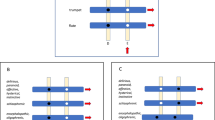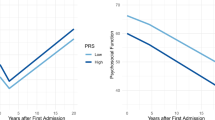Abstract
As part of his lifelong effort to develop optimal nosologic categories for the non-affective delusional syndromes, in the 1913 8th edition of his textbook, Kraepelin proposed a new diagnosis of paraphrenia presenting with extensive bizarre delusions and auditory hallucinations but no prominent negative symptoms or personality deterioration. He tentatively suggested it was distinct from dementia praecox (DP). His proposal was met with controversy. In an attempt to resolve this matter, Wilhelm Mayer, working with Kraepelin in Munich, published in 1921 the result of a follow-up study of the 78 cases of paraphrenia on the basis of which Kraepelin had developed his new diagnosis. In the 74 cases with adequate follow-up, Mayer’s final diagnoses were 43% DP, 38% paraphrenia, and 18% other. He also presented limited family data, suggesting co-aggregation of DP and paraphrenia. On the basis of these results, Mayer argued that paraphrenia was likely better considered to represent a form of DP and not an independent disorder. His opinion was accepted by nearly all subsequent authors. Mayer’s work appeared nearly a half-century before the proposal of Robin and Guze for the validation of psychiatric disorders by follow-up and family studies. The idea of deciding psychiatric questions on empirical grounds—rather than on the prestige of debating parties—is not a recent discovery but can be traced to the roots of our current diagnostic system in the work of Emil Kraepelin and his associates.
This is a preview of subscription content, access via your institution
Access options
Subscribe to this journal
Receive 12 print issues and online access
$259.00 per year
only $21.58 per issue
Buy this article
- Purchase on Springer Link
- Instant access to full article PDF
Prices may be subject to local taxes which are calculated during checkout
Similar content being viewed by others
References
Kraepelin E. Kraepelin on “Paraniod conditions”, Gosline H. I. translator. Alien Neurol. 1916;37:184–210.
Kendler KS. The development of Kraepelin’s mature diagnostic concepts of paranoia (Die Verrucktheit) and Paranoid Dementia Praecox (Dementia Paranoides): a close reading of his textbooks from 1887 to 1899. JAMA Psychiatry. 2018;75:1280–8.
Kraepelin E. Psychiatrie: Ein Lehrbuch Fur Studierende Und Artze. 8th ed. vol 3rd. Leipzig: Johann Ambrosius Barth; 1913.
Kraepelin E. Dementia praecox and paraphrenia; translated by Barclay, RM from the 8th ed of Kraepelin’s textbook. Edinburgh: E&S Livingston; 1919.
Kirby G. Dementia praecox, paraphrenia and paranoia. Am J Psychiatry. 1914;71:349–59.
Castle D. Late paraphrenia. Int J Geriatr Psychiatry. 1999;14:983–4.
Roth M, Kay D. Late paraphrenia: a variant of schizophrenia manifest in late life or an organic clinical syndrome? A review of recent evidence. Int J Geriatr Psychiatry. 1998;13:775–84.
Almeida OP, Howard RJ, Levy R, David AS. Psychotic states arising in late life (late paraphrenia): the role of risk factors. Br J Psychiatry. 1995;166:215–28.
Leonhard K. The classification of endogenous psychoses: translated from the German by Russell Berman. New York, NY: Irvington Publishers, Inc.; 1979.
Krueter A. Deutschsprachige Neurologen und Psychiater. Ein biographisch-bibliographisches Lexikon von den Vorläufern bis zur Mitte des 20. Jahrhunderts. Munich: K. G. Saur; 1996.
Mayer W. Uber paraphrene psychosen. Zentralblatt für die Gesamt Neurol Psychiatr. 1921;71:187–206.
Pfersdorff K. Über paraphrenien. Z für die Gesamt Neurol Psychiatr. 1914;10:95–7.
Krambach R. Über chronische paranoide Erkrankungen (Paraphrenie und Paranoid). Arch für Psychiatr Nervenkrankheiten. 1915;55:911–58.
Krueger H. Die Paranoia: Eine monographische Studie. Berlin: Springer; 1917.
Eisath G. Paranoia, querulantenwahn und paraphrenia. Z für die Gesamt Neurol Psychiatr. 1915;29:12–78.
Hoffmann HF. Ergebnisse der psychiatrischen Erblichkeitsforschung endogener Psychosen seit dem Jahre 1900 unter besonderer Berücksichtigung des manisch-depressiven Irrseins und der Dementia praecox. Z für die Gesamt Neurol Psychiatr. 1919;17:192–234.
Riecher-Rössler A, Rössler W, Förstl H, Meise U. Late-onset schizophrenia and late paraphrenia. Schizophr Bull. 1995;21:345–54.
Kraepelin E, Johannes L. Allgemeine Pychiatrie. Leipzig: Barth; 1927.
Berrios GE. The insanities of the third age: a conceptual history of paraphrenia. J Nutr Health Aging. 2003;7:394–9.
Velthorst E, Fett A-KJ, Reichenberg A, Perlman G, van Os J, Bromet EJ, et al. The 20-year longitudinal trajectories of social functioning in individuals with psychotic disorders. Am J Psychiatry. 2017;174:1075–85.
Tsuang MT, Woolson RF, Winokur G, Crowe RR. Stability of psychiatric diagnosis. Schizophrenia and affective disorders followed up over a 30- to 40-year period. Arch Gen Psychiatry. 1981;38:535–9.
Bromet EJ, Kotov R, Fochtmann LJ, Carlson GA, Tanenberg-Karant M, Ruggero C, et al. Diagnostic shifts during the decade following first admission for psychosis. Am J Psychiatry. 2011;168:1186–94.
Robins E, Guze SB. Establishment of diagnostic validity in psychiatric illness: its application to schizophrenia. Am J Psychiatry. 1970;126:983–7.
Widiger TA, Frances AJ, Pincus HAE, Ross RE. DSM-IV sourcebook, vol. 3. Washington DC: American Psychiatric Publishing, Inc.; 1997.
Kendler KS. A history of the DSM-5 Scientific Review Committee. Psychol Med. 2013;43:1793–800.
dsm@psych.org ADT. GUIDE TO SUBMITTING PROPOSALS FOR CHANGES TO DSM-5. 2022. https://www.psychiatry.org/File%20Library/Psychiatrists/Practice/DSM/DSM5-Proposal-Submissions-General-Guidance.pdf.
American Psychiatric Association. Diagnostic and Statistical Manual of Mental Disorders: Fifth Edition, DSM-5. Washington, DC: American Psychiatric Association; 2013.
Kendler KS. The Development of Kraepelin’s concept of dementia praecox: a close reading of relevant texts. JAMA Psychiatry. 2020;77:1181–7.
Rattray D. Kraepelin’s psychiatry in the pragmatic age. Hist Philos Life Sci. 2022;44:1–35.
Dreyfus GL. Die Melancholie: Ein Zustandsbild des manisch-depressiven Irreseins. Stuttgart-Jena-New York: Jena: Gustav Fischer; 1907.
Kendler KS, Engstrom EJ. Dreyfus and the shift of melancholia in Kraepelin’s textbooks from an involutional to a manic-depressive illness. J Affect Disord. 2020;270:42–50.
Kraepelin E. Psychiatrie: Ein Lehrbuch fur Studirende und Aerzte. 6th ed. Leipzig: Barth; 1899.
Feighner JP, Robins E, Guze SB, Woodruff RA Jr, Winokur G, Munoz R. Diagnostic criteria for use in psychiatric research. Arch Gen Psychiatry. 1972;26:57–63.
Kendler KS, Munoz RA, Murphy G. The development of the Feighner criteria: an historical perspective. Am J Psychiatry. 2010;167:134–42.
Bleuler E. Textbook of psychiatry by Eugen Bleuler translated by AA Brill. New York, NY: Macmillan & Company; 1924.
Mayer-Gross W, Slater E, Roth M. Clinical psychiatry. London: Cassell and Company; 1954.
Gelder M, Gath D, Mayou R. Oxford textbook of psychiatry. 2nd ed. Oxford: Oxford University Press; 1989.
Munro A. A plea for paraphrenia. Can J Psychiatry. 1991;36:667–72.
Ravindran AV, Yatham LN, Munro A. Paraphrenia redefined. Can J Psychiatry. 1999;44:133–7.
Sato A, Ihda S. Paraphrenia and late paraphrenia. Psychogeriatrics. 2002;2:20–5.
Pelizza L, Bonazzi F. Paraphrenia: the modernity of Emil Kraepelin’s thinking. Riv Psichiatria. 2010;45:78–87.
Acknowledgements
Earlier versions of this paper much benefited from comments, assistance in the gathering of references, and the interpretation of the Germans texts by Drs. Stephan Hecker and Eric Engstrom. Astrid Klee MA translated Mayer’s article and also provided helpful comments on earlier versions.
Author information
Authors and Affiliations
Contributions
KSK conceptualized this essay, performed the primary research, and drafted and revised the paper.
Corresponding author
Ethics declarations
Competing interests
The authors declare no competing interests.
Additional information
Publisher’s note Springer Nature remains neutral with regard to jurisdictional claims in published maps and institutional affiliations.
Rights and permissions
Springer Nature or its licensor holds exclusive rights to this article under a publishing agreement with the author(s) or other rightsholder(s); author self-archiving of the accepted manuscript version of this article is solely governed by the terms of such publishing agreement and applicable law.
About this article
Cite this article
Kendler, K.S. Wilhelm Mayer’s follow-up study of Kraepelin’s cases of paraphrenia: diagnostic validity in 1921. Mol Psychiatry 28, 236–241 (2023). https://doi.org/10.1038/s41380-022-01763-9
Received:
Revised:
Accepted:
Published:
Issue Date:
DOI: https://doi.org/10.1038/s41380-022-01763-9



